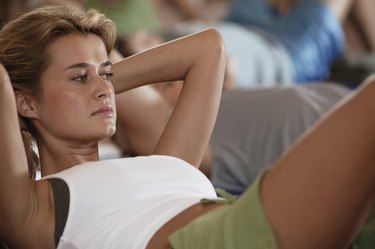
Contrary to popular belief, the classic crunch in not the most effective abdominal exercise. A study conducted by the American Council on Exercise shows the crunch falling short of the top ten exercises. Even so, the crunch can still help tone and develop the muscles at the front and sides of your torso, specifically the rectus abdominis and obliques. When performed regularly, this core-strengthening exercise can help improve your balance, posture, athletic performance and make daily tasks easier.
Crunch Correctly
Video of the Day
To maximize the benefits of the crunch, it's important to perform them with correct form. Lie on your back on an exercise mat, bend your knees and put your feet flat on the mat. Put your hands behind your head or just behind your ears, then flare your elbows out to the sides. Tighten your stomach muscles and pull your belly button toward your spine. Without tilting your tailbone upward, exhale and lift only your shoulder blades and upper back off the mat. Curl up off the mat and pull your rib cage toward your pelvis. Pause for a count of one, inhale and slowly lower your upper body back to the mat to complete one repetition.
Video of the Day
Your Main Frame
The rectus abdominis, or your six-pack muscles, are the primary muscles targeted when you perform crunches. These muscles run vertically along the front of your stomach. They originate at the pubic bone and insert on the fifth, sixth and seventh ribs and the xiphoid process, which is a small projection made of cartilage at the lower part of your breastbone or sternum. The rectus abdominis muscles are instrumental in spinal flexion, the curling of your upper body similar to the movement during a crunch.
Keep Them in Mind
Your obliques, which consist of the internal and external obliques, are also involved as synergists. These muscles assist the main muscle being worked. The obliques run diagonally along the sides of your torso with the internal obliques lying beneath the external obliques. These muscles are instrumental in flexing your spine, rotating your torso, and also bending your torso laterally.
Switch It Up
To increase the intensity of the basic crunch, hold a weight plate against your chest. To focus more on your obliques, make a slight technique change and perform oblique crunches. Position yourself as if you are going to do the basic crunch. During the upward, curling phase, twist your torso to the left and try to touch your right elbow to your left knee. Lower back to the mat and repeat to the right.
Tips and Considerations
To be effective, crunches should be performed with slow and controlled movements -- no fast jerking moves. Avoid pulling on your head during the upward phase and keep your lower back in contact with the mat throughout the exercise. Stop the exercise if you feel any discomfort in your lower back. If you haven't participated in regular exercise for several months or you are susceptible to lower back injuries, consult your health-care provider before starting a new fitness program.
- American Council on Exercise: American Council on Exercise: New Study Puts the Crunch on Ineffective Ab Exercises
- American Council on Exercise: Bent-Knee Sit-up / Crunches
- ExRx.net: Crunch
- Get Body Smart: Muscles that Act on the Abdomen
- ShapeFit.com: Oblique Crunches For Six Pack Abs
- ExRx.net: Kinesiology Glossary
- Muscle and Performance: Crunch Time
- Dartmouth University: The Skeleton of the Thorax